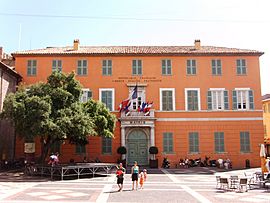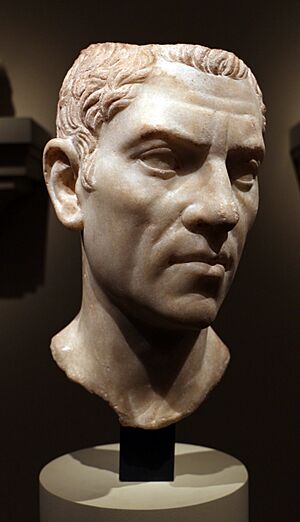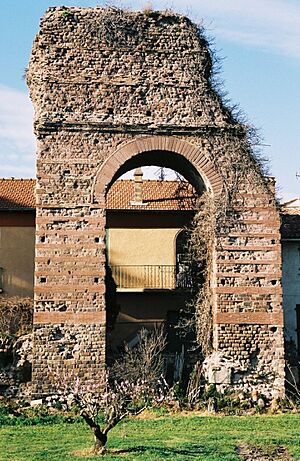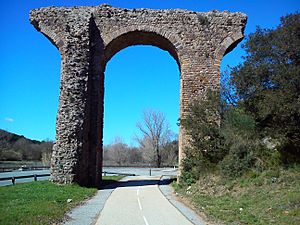Fréjus facts for kids
Quick facts for kids
Fréjus
Frejús (Occitan)
|
|||
|---|---|---|---|

Fréjus Town Hall
|
|||
|
|||
| Country | France | ||
| Region | Provence-Alpes-Côte d'Azur | ||
| Department | Var | ||
| Arrondissement | Draguignan | ||
| Canton | Fréjus and Saint-Raphaël | ||
| Intercommunality | Estérel Côte d'Azur Agglomération | ||
| Area
1
|
102.27 km2 (39.49 sq mi) | ||
| Time zone | UTC+01:00 (CET) | ||
| • Summer (DST) | UTC+02:00 (CEST) | ||
| INSEE/Postal code |
83061 /83600
|
||
| Elevation | 0–616 m (0–2,021 ft) (avg. 8 m or 26 ft) |
||
| 1 French Land Register data, which excludes lakes, ponds, glaciers > 1 km2 (0.386 sq mi or 247 acres) and river estuaries. | |||
Fréjus (Occitan: Frejús) is a town in southeastern France. It is located in the Var area, which is part of the Provence-Alpes-Côte d'Azur region. In 2019, about 54,458 people lived there.
Fréjus is right next to Saint-Raphaël, and together they form one big urban area. The northern part of Fréjus is within the beautiful Massif de l'Esterel mountains. Sadly, on December 2, 1959, the Malpasset Dam broke, causing a flood that affected the city and led to the loss of many lives.
Contents
History of Fréjus
Long ago, people called Celto-Ligures likely settled near a natural harbor in the area where Fréjus is today. You can still see parts of their old defensive walls on Mont Auriasque and Cap Capelin. Later, people from Marseille (called Phocaeans) set up a small trading post here.
How Fréjus Began
Fréjus was in a very important spot, where two major Roman roads met: the Via Julia Augusta and the Via Domitia. Even though there aren't many signs of early settlements, we know that a famous poet named Cornelius Gallus was born here in 67 BC.
Julius Caesar wanted to create a new important city to rival Massalia. So, he founded Fréjus and called it Forum Julii, which means 'market of Julius'. The Roman historian Tacitus even called its port claustra maris, meaning 'gateway to the sea'.
We're not entirely sure of the exact date Fréjus was founded, but it was definitely before 43 BC. Most historians think it was around 49 BC.
Fréjus as a Roman City
After a big battle in 31 BC, Octavius brought his captured ships to Forum Julii. Between 29 and 27 BC, he settled his retired soldiers from the 8th legion here, adding the name Octavanorum Colonia to the city.
In 22 BC, Augustus made Fréjus the capital of a new Roman province called Narbonensis. This helped the city grow very quickly. It became one of the most important ports in the Mediterranean Sea. It was the main naval base for the Roman fleet in Gaul and the second biggest port after Ostia for a long time.
Later, under Emperor Tiberius, many of the impressive buildings you can still see today were built. These include the amphitheater, the aqueduct, the lighthouse, the baths, and the theater. Forum Julii had strong walls that were 3.7 kilometers long, protecting an area of 35 hectares. About six thousand people lived there. The city's land stretched far, from Cabasse in the west to Fayence and Mons in the north.
Fréjus also became a busy market town. People made crafts and grew crops. There were large farms called villa rusticas in places like Villepey and Saint-Raphaël. Mining for green sandstone and blue porphyry, along with fish farming, helped the economy grow.
In 40 AD, Gnaeus Julius Agricola was born in Forum Julii. He later became a famous Roman governor who helped conquer Britain. His son-in-law, the historian Tacitus, wrote that Forum Julii was an "ancient and famous colony." Other ancient writers like Strabo and Pliny the Elder also mentioned the city.
In 69 AD, a battle took place near Forum Julii between the armies of two rival emperors, Otho and Vitellius. The exact spot of this battle is not known.
In the 4th century, the Diocese of Fréjus was created. It was France's second largest after Lyon. The first church was built around 374 AD, and a bishop was chosen. Saint-Léonce became the Bishop of Fréjus in 433 AD. He wrote that he was the first bishop of the city and built the first Cathedral with its Baptistery.
As the Roman Empire declined, so did its cities, including Fréjus.
Roman Buildings and Remains
Fréjus has many amazing Roman buildings, making it one of the richest places in France for Roman architecture, after Arles. The most famous are the amphitheater, the aqueduct from Mons, Var, and the theater.
The old town also has many other impressive remains:
- Parts of the city walls and two gates (of Rome, of Reyran).
- The square of Agricola with the gate of the Gauls.
- An exedra (a curved seating area) and a platform with a water tank on the Butte Saint-Antoine hill.
- Paving from the ancient Via Aurelia road, which passed through the city.
- Remains of the old harbor, including parts of the north quay, the lighthouse, and Augustus's quay.
- A mosaic floor showing fighting roosters in a private home.
- Ancient sewers under the modern Rue Jean Jaures.
- The baptistery in Frejus Cathedral dates back to the 5th century, and its columns came from Roman buildings.
At least five public bathhouses have been found in the city, including those at Porte Dorée, Plate-Forme, les Poiriers, Villeneuve (likely for soldiers), and on the Butte Saint-Antoine. Three of these were outside the city walls.
Archaeologists also found a possible military or naval camp at Aiguières, Villeneuve, near the old shoreline. Some Roman structures are now part of modern buildings, and there's a 4th-century tomb on Rue de La Tourrache. Remains of a Roman country house are at La Rose des Sables. Roman road bridges still exist at Cantonniers and Esclapes (with three arches). There's also a fulling mill (for cleaning cloth) at Arsenal, an ancient burial ground in Sainte-Brigitte, and fishponds on the coast at Saint-Aygulf.
The Aqueduct
The aqueduct that brought water to Fréjus was 42 kilometers long. It ran for 1.8 kilometers on bridges and 500 meters on walls. Many parts of this aqueduct are still very well preserved today.
The Roman Port
In July 2005, archaeologists discovered that the ancient rocky coastline was almost one kilometer further inland than people thought. When Forum Iulii was built in the middle of the 1st century AD, this coastline was a narrow strip about 100 meters wide south of the Butte Saint-Antoine hill.
Recent discoveries have taught us a lot about the ancient port. A statue of Triton (a sea god) was found at the entrance to the harbor. This statue and the remains of a Roman building nearby show that this was likely a lighthouse.
Two lighthouses were built on the quays (docks), and a third helped sailors find the harbor's sea entrance. The third lighthouse, on the Île du Lion de Mer, would have been the main light guiding ships. As ships got closer, the Triton lighthouse on the north side of the channel and another lighthouse on the south side would have marked the entrance, helping them safely enter the harbor.
After the Romans

Between the 7th and 9th centuries, invaders from the sea often attacked Fréjus. The sea also started to cover more land, and attacks by pirates left many of the Roman buildings in ruins. By the 10th century, very little was left of the old Roman city, mostly just rubble. Sea mud clogged up the port, turning it into a huge swampy plain that separated the town from the sea.
Napoleon landed in Fréjus on October 9, 1799, when he returned from Egypt.
During World War I, Fréjus became a major place for soldiers from Senegal to spend the winter. The town also had special hospitals for African soldiers, with paintings of African village life on the walls.
Geography
The beautiful Massif de l'Esterel mountains form a stunning backdrop to Fréjus.
Population Data
| Historical population | |||||||||||||||||||||||||||||||||||||||||||||||||||||||||||||||||||||||||||||||||||||||||||||||||||||||||||||||||||
|---|---|---|---|---|---|---|---|---|---|---|---|---|---|---|---|---|---|---|---|---|---|---|---|---|---|---|---|---|---|---|---|---|---|---|---|---|---|---|---|---|---|---|---|---|---|---|---|---|---|---|---|---|---|---|---|---|---|---|---|---|---|---|---|---|---|---|---|---|---|---|---|---|---|---|---|---|---|---|---|---|---|---|---|---|---|---|---|---|---|---|---|---|---|---|---|---|---|---|---|---|---|---|---|---|---|---|---|---|---|---|---|---|---|---|---|
|
|
||||||||||||||||||||||||||||||||||||||||||||||||||||||||||||||||||||||||||||||||||||||||||||||||||||||||||||||||||
| Source: EHESS and INSEE (1968–2017) | |||||||||||||||||||||||||||||||||||||||||||||||||||||||||||||||||||||||||||||||||||||||||||||||||||||||||||||||||||
Politics and Mayors
In 2014, David Rachline was elected as the Mayor of Fréjus. He belongs to the National Rally political party.
| Start | End | Name | Party | |
|---|---|---|---|---|
| 1977 | 1997 | François Léotard | UDF–PR | |
| 1997 | 2014 | Élie Brun | UMP | |
| 2014 | Present | David Rachline | FN/RN | |
Economy and Tourism
Fréjus is a popular resort town, especially in the summer. Its population can grow three to four times bigger during the holiday season!
The town hosts several events throughout the year, like a pottery fair and the Bravade festival. Visitors enjoy its Roman and Gothic buildings with their unique 'old tile' rooftops and colorful walls.
Port Fréjus is a harbor that can hold 750 boats and is surrounded by beautiful sandy beaches. Fréjus also hosts an annual mountain bike event called 'Roc d'Azur'.
Transportation
The Fréjus railway station connects the town to nearby places like Saint-Raphaël, Les Arcs, and Cannes. For longer journeys, people can use the Saint-Raphaël-Valescure station nearby. The A8 autoroute is a major highway that links Fréjus to cities like Aix-en-Provence and Nice.
Climate
Fréjus has a hot-summer Mediterranean climate. This means it has hot, dry summers and mild, wet winters.
| Climate data for Fréjus (1991–2020 averages, extremes 1919–present) | |||||||||||||
|---|---|---|---|---|---|---|---|---|---|---|---|---|---|
| Month | Jan | Feb | Mar | Apr | May | Jun | Jul | Aug | Sep | Oct | Nov | Dec | Year |
| Record high °C (°F) | 22.8 (73.0) |
26.4 (79.5) |
27.3 (81.1) |
28.3 (82.9) |
32.6 (90.7) |
37.7 (99.9) |
42.5 (108.5) |
41.5 (106.7) |
35.4 (95.7) |
35.9 (96.6) |
26.6 (79.9) |
23.2 (73.8) |
42.5 (108.5) |
| Mean daily maximum °C (°F) | 13.3 (55.9) |
14.0 (57.2) |
16.3 (61.3) |
18.6 (65.5) |
22.4 (72.3) |
26.3 (79.3) |
29.1 (84.4) |
29.3 (84.7) |
25.6 (78.1) |
21.5 (70.7) |
16.9 (62.4) |
13.7 (56.7) |
20.6 (69.1) |
| Daily mean °C (°F) | 8.6 (47.5) |
8.9 (48.0) |
11.2 (52.2) |
13.6 (56.5) |
17.4 (63.3) |
21.2 (70.2) |
23.8 (74.8) |
24.0 (75.2) |
20.5 (68.9) |
16.9 (62.4) |
12.5 (54.5) |
9.3 (48.7) |
15.7 (60.3) |
| Mean daily minimum °C (°F) | 4.0 (39.2) |
3.8 (38.8) |
6.1 (43.0) |
8.6 (47.5) |
12.6 (54.7) |
16.2 (61.2) |
18.6 (65.5) |
18.7 (65.7) |
15.4 (59.7) |
12.2 (54.0) |
8.0 (46.4) |
4.9 (40.8) |
10.8 (51.4) |
| Record low °C (°F) | −9.0 (15.8) |
−12.0 (10.4) |
−8.6 (16.5) |
−1.8 (28.8) |
1.1 (34.0) |
5.5 (41.9) |
7.5 (45.5) |
7.7 (45.9) |
4.5 (40.1) |
0.1 (32.2) |
−3.3 (26.1) |
−7.0 (19.4) |
−12.0 (10.4) |
| Average precipitation mm (inches) | 69.8 (2.75) |
51.6 (2.03) |
49.6 (1.95) |
70.2 (2.76) |
43.9 (1.73) |
31.8 (1.25) |
15.6 (0.61) |
27.2 (1.07) |
81.0 (3.19) |
115.5 (4.55) |
132.5 (5.22) |
96.9 (3.81) |
785.6 (30.93) |
| Average precipitation days (≥ 1.0 mm) | 5.7 | 5.1 | 5.0 | 6.4 | 5.0 | 3.4 | 1.4 | 2.1 | 4.8 | 7.4 | 8.3 | 6.5 | 61.3 |
| Average snowy days | 0.7 | 0.4 | 0.1 | 0.0 | 0.0 | 0.0 | 0.0 | 0.0 | 0.0 | 0.0 | 0.1 | 0.2 | 1.5 |
| Average relative humidity (%) | 75 | 73 | 72 | 73 | 76 | 75 | 73 | 74 | 77 | 78 | 77 | 76 | 74.9 |
| Mean monthly sunshine hours | 155.9 | 166.6 | 217.7 | 220.7 | 264.9 | 311.1 | 346.1 | 313.4 | 234.2 | 171.9 | 141.6 | 121.2 | 2,665.2 |
| Source 1: Meteo France, Meteociel.fr (sun 1981-2010) | |||||||||||||
| Source 2: Infoclimat.fr (humidity and snowy days 1961–1990) | |||||||||||||
Twin Towns and Sister Cities
Fréjus has special partnerships with other towns around the world. These are called "twin towns" or "sister cities":
 Fredericksburg, Virginia, United States
Fredericksburg, Virginia, United States Triberg, Germany
Triberg, Germany Dumbéa, New Caledonia
Dumbéa, New Caledonia Paola, Italy
Paola, Italy Tabarka, Tunisia
Tabarka, Tunisia
Famous People from Fréjus

Many interesting people have connections to Fréjus:
- Cornelius Gallus (around 70–26 BC), a Roman poet, speaker, and politician.
- Gnaeus Julius Agricola (40–93 AD), a Roman governor who helped conquer Britain.
- St. Maximus (died 460), a religious leader and Bishop of Fréjus.
- Marc-Antoine Désaugiers (1742–1793) and Marc-Antoine Madeleine Désaugiers (1772–1827), French composers.
- Emmanuel Joseph Sieyès (1748–1836), known as Abbé Sieyès, a thinker during the French Revolution.
- Belinda Carlisle (born 1958), an American singer and author, lived here for many years.
- Casey Legler (born 1977), a French-American writer, model, and former Olympic swimmer.
- Anna Mouglalis (born 1978), a French actress and model.
- David Rachline (born 1987), a politician and the current mayor of Fréjus.
Sports Stars
- Odiah Sidibe (born 1970), a French sprint athlete.
- Yoann Richomme (born 1983), a French sailor and yacht skipper.
- Adil Rami (born 1985), a famous footballer who played for many clubs and for the French national team.
- Marc Andreu (born 1985), a rugby union player.
- Kévin Constant (born 1987), a footballer who played for many clubs and for the Guinea national team.
- Anthony Modeste (born 1988), a French footballer.
- Layvin Kurzawa (born 1992), a footballer who played for many clubs and for the French national team.
Images for kids
See also
 In Spanish: Fréjus para niños
In Spanish: Fréjus para niños
- Bishopric of Fréjus
- Malpasset
- Communes of the Var department













